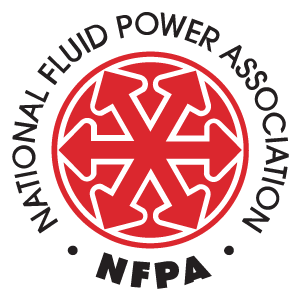A new publication, the 2023 NFPA Technology Roadmap: Improving the Design, Manufacture and Function of Fluid Power Components and Systems, has been published by the National Fluid Power Association. Copies can be downloaded after a brief registration process on our website.
Every other year, the National Fluid Power Association (NFPA) engages with stakeholders across the fluid power supply chain to refresh and re-publish its Technology Roadmap for the Fluid Power Industry. The NFPA Roadmap is a document that describes the evolving needs of companies in fluid power’s many customer markets, the degree to which fluid power is capable of meeting those needs, and the R&D objectives that will help fluid power meet or better meet those needs in the future.
The process is overseen by the NFPA Roadmap Committee – which for this cycle was chaired by Bradlee Dittmer of NORGREN and vice-chaired by Steve Meislahn of Sun Hydraulics/Helios. The committee and its several working groups met multiple times over an eight-month period of time to review the results of numerous stakeholder surveys and to develop the various elements of the new Roadmap. Among its many findings are the following eight Customer Strategies, the primary machine-level objectives or technologies that are currently being deployed to help machine builders in fluid power customer markets achieve their performance objectives.
- Autonomy. Either semi- or fully-autonomous functions and/or operations.
- Compactness. Increasing power density and/or reducing weight and/or size.
- Connectivity. Expanding the use of data, such as intelligence for cloud-based condition monitoring, integration with site management systems, and/or communicating machine status for other value-added purposes.
- Electrification. Decarbonizing prime movers through a variety of strategies.
- Energy Efficiency. Increasing it; and including strategies to improve battery life and/or charging and to use less energy and/or reduce emissions.
- Maintenance. Making it easier; and including strategies to ease the serviceability of the machine and to increase the availability of repair and replacement parts.
- Materials. Use of conflict and/or environmentally friendly materials in strategic ways to better comply with regulations.
- Noise. Reducing perceived noise levels and/or improving noise pulsation.
The Roadmap also identifies the following eight Capability Improvements as the primary ways in which fluid power systems should seek improvements in order to strengthen its use in and connection to these Customer Strategies.
- Data. Improving ability to monitor, gather, and use data generated from fluid power products and/or systems.
- Ease of Use. Improving ease of use and application of fluid power (through automated control, communications, increased dynamic performance, etc.).
- Energy Efficiency. Increasing the energy efficiency of fluid power products and/or systems.
- Environmental Impact. Reducing the environmental impact of fluid power products and/or systems (i.e., leaks, sustainable materials, damage to environment).
- Noise. Reducing the level and harshness of the noise generated by fluid power products and/or systems.
- Power Density. Increasing the power density of fluid power products and/or systems.
- Reliability and Durability. Improving the reliability and/or durability of fluid power products and/or systems.
- Safety. Improving the safe use and application of fluid power products and/or systems.
Specific pre-competitive Research Areas and Targets are also identified to assist in bringing about these improvements. Organizations that wish to pursue projects of importance to the fluid power industry should seek alignment with these Research Areas and Targets.
Special thanks goes to the many partner associations, including some representing key customer markets, whose members participated in the various surveys and committee discussions. These associations include the Association for High Technology Distribution (AHTD), the Power Transmission Distributors Association (PTDA), the Packaging Machinery Manufacturers Institute (PMMI), the Association of Equipment Manufacturers (AEM), and the Association for Manufacturing Technology (AMT).
Eric Lanke, NFPA President/CEO, is available to present the Roadmap and its findings to your group or company. Contact him at elanke@nfpa.com if you have interest.
Like this post? Share it!
Recent Posts
Member Highlights the Value of NFPA’s Conferences
At NFPA, our members’ experiences are the foundation of what we do. We’re excited to share our latest testimonial video featuring Ken Baker, CEO of Bailey International, who underscores the value of attending NFPA events. In his video, Ken highlights how the Economic & Industry Outlook Conference provides invaluable insights for his business. From the…
NAM Regulatory Update: House Passes Critical Minerals Bill
As part of an effort to bring more information about the regulatory and legal environment facing American manufacturers, NFPA is monitoring the newsfeed of the National Association of Manufacturers (NAM) and will be bringing important updates like this to the attention of NFPA members. (November 15, 2024) The House easily passed an NAM-backed bill intended…
Fall 2024 Economic Update Webinar – Recording Available
The most recent NFPA Economic Update Webinar featured Lauren Saidel-Baker of ITR Economics. Learn what to expect from a number of our industry’s most popular customer markets, while also getting the answers you need to the short-term outlook for the fluid power industry. These insights and more are available to NFPA members in the archived recording of the…



